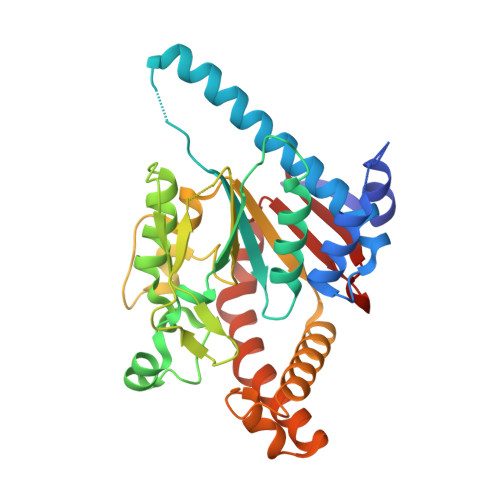The structure of the pantothenate kinase.ADP.pantothenate ternary complex reveals the relationship between the binding sites for substrate, allosteric regulator, and antimetabolites.
Ivey, R.A., Zhang, Y.-M., Virga, K.G., Hevener, K., Lee, R.E., Rock, C.O., Jackowski, S., Park, H.-W.(2004) J Biol Chem 279: 35622-35629
- PubMed: 15136582
- DOI: https://doi.org/10.1074/jbc.M403152200
- Primary Citation of Related Structures:
1SQ5 - PubMed Abstract:
Pantothenate kinase catalyzes the first step in the biosynthesis of coenzyme A, the major acyl group carrier in biology. In bacteria, regulation of pantothenate kinase activity is a major factor in controlling intracellular coenzyme A levels, and pantothenate analogs are growth-inhibiting antimetabolites. We have extended the structural information on Escherichia coli pantothenate kinase by determining the structure of the enzyme.ADP. pantothenate ternary complex. Pantothenate binding induces a significant conformational change in amino acids 243-263, which form a "lid" that folds over the open pantothenate binding groove. The positioning of the substrates suggests the reaction proceeds by a concerted mechanism that involves a dissociative transition state, although the negative charge neutralization of the gamma-phosphate by Arg-243, Lys-101, and Mg(2+) coupled with hydrogen bonding of the C1 of pantothenate to Asp-127 suggests different interpretations of the phosphoryl transfer mechanism of pantothenate kinase. N-alkylpantothenamides are substrates for pantothenate kinase. Modeling these antimetabolites into the pantothenate active site predicts that they bind in the same orientation as pantothenate with their alkyl chains interacting with the hydrophobic dome over the pantothenate pocket, which is also accessed by the beta-mercaptoethylamine moiety of the allosteric regulator, coenzyme A. These structural/biochemical studies illustrate the intimate relationship between the substrate, allosteric regulator, and antimetabolite binding sites on pantothenate kinase and provide a framework for studies of its catalysis and feedback regulation.
Organizational Affiliation:
Department of Structural Biology, St. Jude Children's Research Hospital, Memphis, Tennessee 38105, USA.
















